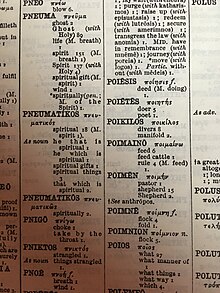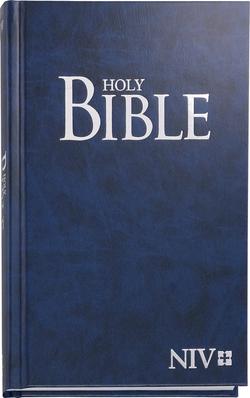
The New International Version (NIV) is a translation of the Bible into contemporary English. Published by Biblica, the complete NIV was released in 1978 with a minor revision in 1984 and a major revision in 2011. The NIV relies on recently-published critical editions of the original Hebrew, Aramaic, and Greek texts.
Jah or Yah is a short form of יהוה (YHWH), the four letters that form the tetragrammaton, the personal name of God: Yahweh, which the ancient Israelites used. The conventional Christian English pronunciation of Jah is, even though the letter J here transliterates the palatal approximant. The spelling Yah is designed to make the pronunciation explicit in an English-language context, especially for Christians who may not use Hebrew regularly during prayer and study.

The New American Standard Bible (NASB) is a translation of the Bible in contemporary English. Published by the Lockman Foundation, the complete NASB was released in 1971. The NASB relies on recently published critical editions of the original Hebrew, Aramaic, and Greek texts.

The Exhaustive Concordance of the Bible, generally known as Strong's Concordance, is a Bible concordance, an index of every word in the King James Version (KJV), constructed under the direction of James Strong. Strong first published his Concordance in 1890, while professor of exegetical theology at Drew Theological Seminary.
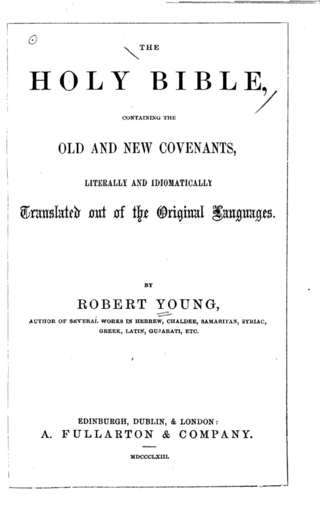
Young's Literal Translation (YLT) is a translation of the Bible into English, published in 1862. The translation was made by Robert Young, compiler of Young's Analytical Concordance to the Bible and Concise Critical Comments on the New Testament. Young used the Textus Receptus (TR) and the Masoretic Text (MT) as the basis for his translation. He wrote in the preface to the first edition, "It has been no part of the Translator's plan to attempt to form a New Hebrew or Greek Text—he has therefore somewhat rigidly adhered to the received ones." Young produced a "Revised Version" of his translation in 1887, but he stuck with the Received Text. He wrote in the preface to the Revised Edition, "The Greek Text followed is that generally recognized as the 'Received Text,' not because it is thought perfect, but because the department of Translation is quite distinct from that of textual criticism, and few are qualified for both. If the original text be altered by a translator, the reader is left in uncertainty whether the translation given is to be considered as that of the old or of the new reading." A new Revised Edition was released ten years after Robert Young's death on October 14, 1888. The 1898 version was based on the TR, easily confirmed by the word "bathe" in Revelation 1:5 and the word "again" in Revelation 20:5. The "Publishers' Note to the Third Edition" explains, "The work has been subjected to a fresh revision, making no alteration on the principles on which the Translation proceeds, but endeavouring to make it as nearly perfect in point of accuracy on its present lines as possible."
The Amplified Bible (AMP) is an English language translation of the Bible produced jointly by Zondervan and The Lockman Foundation. The first edition as a complete volume was published in 1965. "Amplifications" are words or phrases intended to more fully bring out the meaning of the original text but distinguished from the translation itself by a unique system of brackets, parentheses, and italics. The translation is largely one of formal equivalence (word-for-word).
Koinonia is a transliterated form of the Greek word κοινωνία, which refers to concepts such as fellowship, joint participation, partnership, the share which one has in anything, a gift jointly contributed, a collection, a contribution. In the Politics of Aristotle it is used to mean a community of any size from a single family to a polis. As a polis, it is the Greek for republic or commonwealth. In later Christianity it identifies the idealized state of fellowship and unity that should exist within the Christian church, the Body of Christ. This usage may have been borrowed from the early Epicureans—as it is used by Epicurus' Principal Doctrines 37–38.

Jehovah is a Latinization of the Hebrew יְהֹוָהYəhōwā, one vocalization of the Tetragrammaton יהוה (YHWH), the proper name of the God of Israel in the Hebrew Bible/Old Testament. The Tetragrammaton יהוה is considered one of the seven names of God in Judaism and a form of God's name in Christianity.

James Strong was an American academic, biblical scholar, lexicographer, Methodist theologian and professor, best known for being the creator of Strong's Concordance.

A Hebrew and English Lexicon of the Old Testament, more commonly known as Brown–Driver–Briggs or BDB is a standard reference for Biblical Hebrew and Biblical Aramaic, first published in 1906. It is organized by (Hebrew) alphabetical order of three letter roots. It was based on the Hebrew-German lexicon of Wilhelm Gesenius, translated by Edward Robinson. The chief editor was Francis Brown, with the co-operation of Samuel Rolles Driver and Charles Augustus Briggs, hence the name Brown–Driver–Briggs. Some modern printings have added the Strong's reference numbers for Biblical Hebrew and Aramaic words.
The Concordant Version is an English translation of the Bible compiled by the Concordant Publishing Concern (CPC), which was founded by Adolph Ernst Knoch in 1909. The principal works of the CPC are the Concordant Literal New Testament with Keyword Concordance (CLNT) and the Concordant Version of the Old Testament (CVOT). A. E. Knoch designed the Concordant Version in such a way as to put the English reader who lacks a formal knowledge of Koine Greek in possession of all the vital facts of the most ancient codices: Codex Vaticanus, Codex Sinaiticus, and Codex Alexandrinus. The CPC's efforts yielded a restored Greek text, titled The Concordant Greek Text, containing all of the important variant readings found in the codices mentioned above. This was done with the intent of conforming, as far as possible, to the original autograph manuscripts. An utterly consistent hyper-literal sub-linear based upon a standard English equivalent for each Greek element is to be found beneath each Greek word. The Concordant Greek Text forms the basis of the Concordant Literal New Testament, which is more idiomatic in its English than the hyper-literal sublinear. The Concordant Literal New Testament and the Concordant Greek Text are linked together and correlated for the English reader by means of an English concordance—the Keyword Concordance—and a complementary list of the Greek elements.
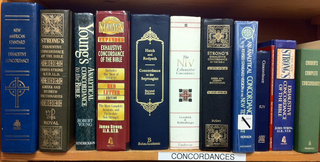
A Bible concordance is a concordance, or verbal index, to the Bible. A simple form lists Biblical words alphabetically, with indications to enable the inquirer to find the passages of the Bible where the words occur.
In Biblical studies, a gloss or glossa is an annotation written on margins or within the text of biblical manuscripts or printed editions of the scriptures. With regard to the Hebrew texts, the glosses chiefly contained explanations of purely verbal difficulties of the text; some of these glosses are of importance for the correct reading or understanding of the original Hebrew, while nearly all have contributed to its uniform transmission since the 11th century. Later on, Christian glosses also contained scriptural commentaries; St. Jerome extensively used glosses in the process of translation of the Latin Vulgate Bible.
Nephesh is a Biblical Hebrew word which occurs in the Hebrew Bible. The word refers to the aspects of sentience, and human beings and other animals are both described as being nephesh. Bugs and plants, as examples of live organisms, are not referred in the Bible as being nephesh. The primary meaning of the term נפש is 'the breath of life' instinct in the nostrils of all living beings, and by extension 'life', 'person' or 'very self'. There is no term in English corresponding to nephesh, and the (Christian) 'soul', which has quite different connotations is nonetheless customarily used to translate it. One view is that nephesh relates to sentient being without the idea of life and that, rather than having a nephesh, a sentient creation of God is a nephesh. In Genesis 2:7, the text is not that Adam was given a nephesh but that Adam "became a living nephesh." Nephesh when put with another word can detail aspects related to the concept of nephesh; with רוּחַ rûach it describes a part of mankind that is immaterial, like one's mind, emotions, will, intellect, personality, and conscience, as in Job 7:11.
The Apostolic Bible Polyglot (ABP), originally published in 2003 is a Bible translation by Charles VanderPool. The ABP is an English translation with a Greek interlinear gloss and is keyed to a concordance. The numbering system, called "AB-Strong's", is a modified version of Strong's concordance, which was designed only to handle the traditional Hebrew Masoretic Text of the Old Testament, and the Greek text of the New Testament. Strong's concordance doesn't have numbering for the Greek O.T. The ABP utilizes a Greek Septuagint base for the O.T. and, therefore, required a modified system. The numbers and the Greek word appear immediately above the English translation instead of side by side, as is common in many interlinears.
kephalē appears some 75 times in the Greek New Testament. It is of considerable interest today because of differences of biblical interpretation between Christian egalitarians and Complementarians as to the intent of the New Testament concerning roles of authority assigned biblically to husbands and wives. A prime example appears in Ephesians 5:21–24 where all Christians are told:
Isaiah 24 is the 24th chapter of the Book of Isaiah in the Hebrew Bible or the Old Testament of the Christian Bible. This book contains the prophecies attributed to the prophet Isaiah, and is one of the Books of the Prophets. Chapters 24-27 of Isaiah constitute one unit of prophecy sometimes called the "Isaiah Apocalypse". Chapter 24 contains the prophecy on the destruction of Judah for its defilements and transgressions, while a remnant will praise God, and God, by his judgments on his people and their enemies, will advance his kingdom.
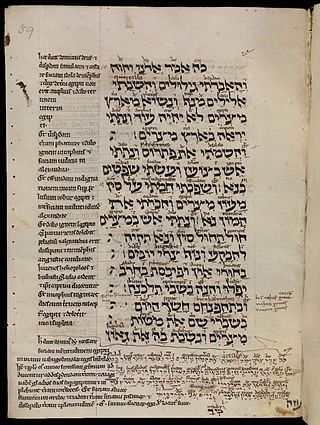
Ezekiel 9 is the ninth chapter of the Book of Ezekiel in the Hebrew Bible or the Old Testament of the Christian Bible. This book contains the prophecies attributed to the prophet/priest Ezekiel, and is one of the Books of the Prophets. This chapter, sub-titled "The Wicked Are Slain" in the New King James Version, contains God's "judgment on the idolaters" who defiled the temple in Jerusalem. Ezekiel's vision of the defiled temple continues as far as Ezekiel 11:25.

Ezekiel 19 is the nineteenth chapter of the Book of Ezekiel in the Hebrew Bible or the Old Testament of the Christian Bible. This book contains the prophecies attributed to the prophet/priest Ezekiel, and is one of the Books of the Prophets. This chapter contains a kinah or lamentation for the rulers of Israel. Two princes are lamented, one captured and carried to Egypt, i.e. Jehoahaz, son and successor of Josiah, and another carried to Babylon, who must be Jehoiachin.

Ezekiel 27 is the twenty-seventh chapter of the Book of Ezekiel in the Hebrew Bible or the Old Testament of the Christian Bible. This book contains the prophecies attributed to the prophet/priest Ezekiel, and is one of the Books of the Prophets. This chapter contains a lamentation for the fallen city of Tyre.
